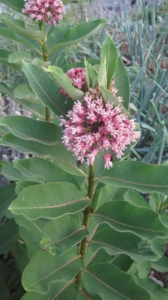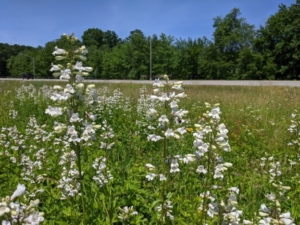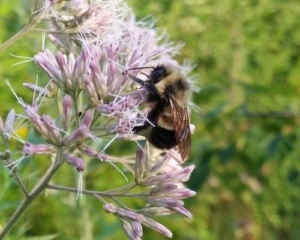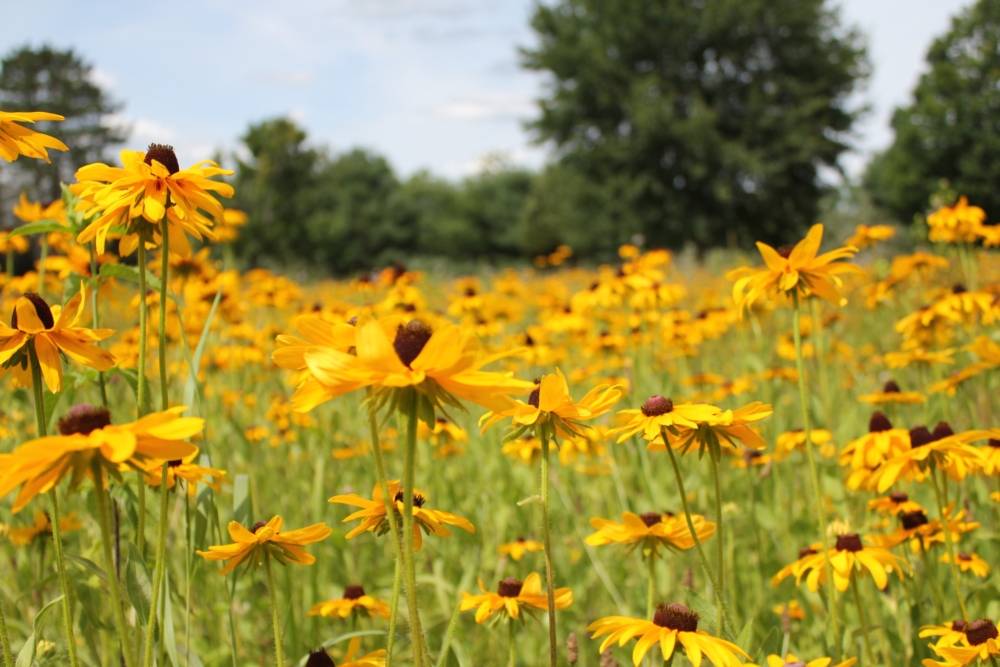Cover Photo Route 6 between Willimantic and Coventry
Sources: Ed Stannard, Hartford Courant; Anna Zarra Aldrich, Office of the Vice President for Research, UCONN; Professor Julia Kuzovkina, Plant Science, University of Connecticut
By Barbara Heimlich
Editor
Professor Julia Kuzovkina, a professor of Plant Science,of the University of Connecticut, knows many people would like to see milkweed, foxglove beardtongue and other wildflowers, along with the butterflies and bees they attract on our highways, and believes that replanting the side of a our highways will benefit the environment by reducing the need for mowing and by promoting biodiversity in the landscape.
Professor Kuzovkina received a grant from the New England Transportation Consortium to set up a pilot project on I-91 near Exit 38 in Windsor, next to a commuter lot, one of three such sites in New England. The others are near Holyoke, Mass., and in northern Vermont. I-95 connects the I-91 corridor with the southern regions, thus it is part of this proposed migration corridor.
The New England Transportation Consortium, (NETC) is a research cooperative between the state transportation agencies of Connecticut, Maine, Massachusetts, New Hampshire, Rhode Island and Vermont.
The consortium is supported by the New England states’ transportation departments’ research funds. “They want to preserve and to assist pollinators,” Kuzovkina said. “Because of the crisis in pollinators we need to improve habitats for predators and many insects.” Those habitats will be planted with native seed, she said.
One advantage of using I-91 and planting milkweed is that it will help monarch butterflies on their southerly migration route to Mexico. The butterflies will feed only on milkweed leaves. A challenge for butterflies is that the areas where they can feed now are “fragmented landscapes,” John Campanelli, a graduate student working on the project, said.
“So anytime the pollinators have to expend energy to get from one [to another] to forage for pollen and nectar and so forth puts them at risk, and roadways are these connected corridors, or they’re in essence unfragmented landscapes,” he said.
Because roadsides are long, continuous strips of land, they provide migration pathways for pollinators. Many pollinators have lost these pathways in recent years as human developments fragment landscapes. This means pollinators need to expend extra energy to travel between patches of habitat, making the trip more taxing and dangerous.
“Roadsides constitute a lot of land,” Campanelli, says. “So their impact, ecologically, is far more than people realize.” Roadside flora also provides ecosystem services like runoff filtration, carbon sequestration, supporting biodiverse habitats, and improving aesthetics.
 The grant will establish demonstration sites in three different New England states. The researchers say they are currently considering areas along Interstate 91 since it corresponds with monarch butterflies’ migration route.
The grant will establish demonstration sites in three different New England states. The researchers say they are currently considering areas along Interstate 91 since it corresponds with monarch butterflies’ migration route.
One change Kuzovkina’s team will implement in these test sites is swapping out the “cool-season” turf grasses currently planted along roadsides with more ecologically appropriate “warm-season” grasses.
As their names suggest, cool-season grasses can grow in both warm and cool seasons, while warm-season grasses only grow in warmer seasons, meaning they need to be mowed less frequently.
“A second aspect is that we want to promote reduced mowing in New England because once you stop mowing many native plants proliferate,” Kuzovkina said.
“There are some conflicts in opinions,” she added. “Some people find them attractive and some people find them not neat enough. … Conventionally, they expect mowed roadsides, but we encourage unmowed roadsides.
I-91 is the second project in the state to replace mowed turf grass with wildflowers. The first was along Route 6 in Willimantic and Columbia. “There are two important species that we’ve noticed have proliferated because of reduced mowing,” Campanelli said.
“In particular milkweed, which is necessary for monarch butterflies, has been proliferating greatly because of it,” he said. “And we also noticed something called penstamen (foxglove beardtongue), which we haven’t seen along a road before but because of the reduced mowing, it’s starting to emerge.
What can we do NOW?
Dr. Kuzovkina said that we could build a strong movement with this specific mission. “There is considerable enthusiasm from people at many levels. We should start with a coalition of federal, state, local agencies, concerned citizen groups such as the Pollinator Partnership; academia, the green industry, volunteers, schools, underserved groups, who can help raise plant material (such as veterans, the incarcerated, and disabled) – they all can assist during different activities/phases of the project

Penstamen is a group of species commonly called beardtongue. They bloom early in the spring, “which is important because, for instance, bumblebees … nest in the ground, and their lifecycle starts in March.”
Route 6 has been designated a conservation road, Kuzovkina said, which is mowed “only once a year at the end of the season at the end of October, November. This allows native seed to be dispersed. And the seeds germinate next year. This is an environmentally safe approach to promote native populations in the region.”
“The particular seed plants that we use and the seeds that we use, that were harvested from the New England area, and they will grow there because they grow under our climatic conditions, and therefore we know that they persist more likely than if they originate from another region,” Campanelli said.
Besides butterflies, the native roadsides will attract a variety of bees, which are native pollinators, Kuzovkina said. “So for example, we would be able to have a few species of bumblebees … or sweat bees or mason bees.”
Among the bumblebees is a species called rusty patched bumblebee, which is important to native blueberries and “which is at risk in New England,” Kuzovkina said.
“So anything that would cater to it would then benefit wild blueberry farmers,” Campanelli said.
“This whole exercise is about transitioning to a more sustainable product, maintenance and so forth,” he said. “Unfortunately, it requires changing bureaucratic behavior because how you establish turf grass and how you establish native plant communities are far different. And it’s far more complicated.”
What can we do NOW?
Dr. Kuzovkina said that we could build a strong movement with this specific mission.
“There is considerable enthusiasm from people at many levels. We should start with a coalition of federal, state, local agencies, concerned citizen groups such as the Pollinator Partnership, academia, the green industry, volunteers, schools, underserved groups, who can help raise plant material (such as veterans, the incarcerated, and disabled) – they all can assist during different activities/phases of the project.
The Pollinator Partnership (https://www.pollinator.org/about) works with a diverse set of partners including local, regional, and national governments; corporations; universities and others that are making exceptional pollinator protection happen across North America and beyond.
The funding for our work comes from over 3000 individual sources. This diversity ensures that we are entirely neutral and science-driven. Pollinator Partnership has many supporters, each with unique missions of their own. We see it as our responsibility to hear these diverse perspectives and deliver science-based policy and programs that drive our organizational mission: saving our pollinators in every way we can. This includes minimizing the use and impact of pesticides. No matter what the funding source, we have an unblemished record of impartiality.

